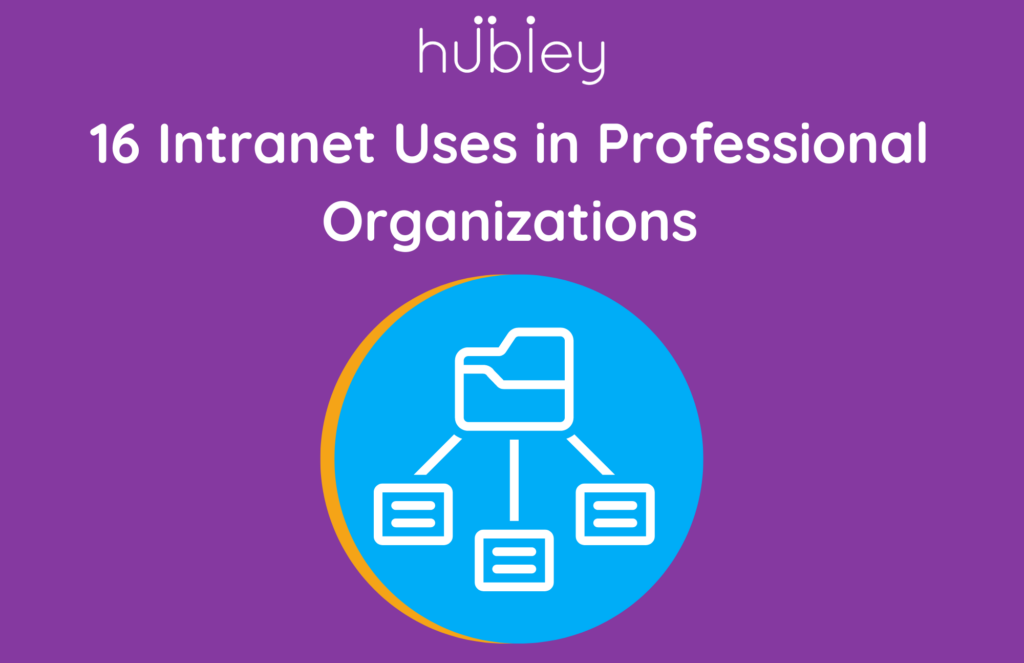Seventy-two percent of employees say they regularly miss out on critical company information. In light of that statistic, businesses everywhere are always looking for ways to foster better communication, collaboration, and productivity among employees and teams. If this sounds like your organization, it may be time to consider an intranet.
Unlike the internet, an intranet is not a worldwide web. Instead, employees use a private enterprise network to communicate, store files, and complete administrative tasks. While the intranets of old functioned as little more than online bulletin boards, modern intranets have grown into robust software platforms with a plethora of capabilities.
Effective workplace communication has been shown to increase workplace productivity by at least 25%. If you’ve never considered using an intranet in your business, read on to learn how adopting one can bring value to your organization regardless of your industry.
What’s the Value of Having an Intranet?
Because today’s intranets run on modern technology, their value extends far beyond posting information or event details. Below are two significant ways having an intranet can improve your business.
Enhancing Internal Communication
An intranet makes communicating among teams a breeze. For instance, it allows:
- Executive teams to quickly get announcements out to employees
- Managers to communicate with teams without personal devices or email threads
- Employees communicate safely and efficiently.
Best of all, an intranet enables organizational members to share in many ways, including through video and audio.
Beyond just announcements and check-ins, there may be times when your executive team or human resources department needs to share critical updates to official policies and receive a response. Intranets are the perfect solution for forgoing unreliable paper documents and ensuring that the intended parties receive what they need and can respond accordingly.
Creating a Central Source of Truth
Document control is a hallmark of today’s business operations. This is especially true in a world where collaboration is key.
Modern Cloud-based intranets make it possible to create a central source of truth by allowing multiple parties simultaneous access to the same document. An intranet will also record essential information about each document, such as ownership and details about when and by whom it has been edited.
Uses of an Intranet in Organizations
Intranets have countless use cases in organizations. If you’re wondering whether a cloud-based intranet will work for your business, the following represent a few examples of how you might implement it in key industries.
General Uses of an Intranet
Some of the most popular uses of an intranet across organizations of all types include:
- Creating a company directory
- Building a social networking platform
- Automating forms and paperwork signatures
- Managing projects and calendars
- Providing access to pay stubs
- Maintaining onboarding and policy documents
- Recognizing hard-working employees
- Creating a CEO or executive team blog
- Building a learning and information hub
- Conducting feedback surveys and polls
These are some of the ways that any enterprise can benefit from intranet use. In the following sections, you’ll find use cases for businesses and organizations in specific industries.
Uses of Intranet in Businesses
Running a business is all about increasing efficiency without sacrificing the quality of products and services. Intranets help companies meet this goal by centralizing important information for executives and employees.
Training materials, pricing guides, standard operating procedures, and business intelligence reports can all be stored on the same platform. For further customization, you can allow different access permissions based on role.
Business moves fast, and a good intranet solution can keep pace with it. For instance, you can do everything from using a calendar to simplify shift scheduling to using alerts to keep employees informed about important developments such as:
- Product launches
- Executive team store visits
- Upcoming events
- Outstanding team members
With all the capabilities it can provide, an intranet truly has the power to change how you do business.
Uses of Intranet in Schools
More than ever, schools must ensure that students, teachers, and administrators are on the same page. Fortunately, an intranet system fosters quality communication by funneling it through a single channel.
This allows administrators to share critical operational information and ensure understanding. And crucially, they can do so without distributing paper documentation or having educators take time out of their busy days for unnecessary meetings.
Instead, policies can be delivered to students and staff and tracked with ease, and central office or campus administrators can display professional development dates and keep tabs on attendance. Organizational charts and a searchable staff directory also make it easy for staff to contact administrators for help when needed.
For educators, having an intranet creates an opportunity for collaborating on office hours, student success plans, and departmental projects. Intranets make sticky notes, countless paper copies, and lengthy email chains a thing of the past. Teachers can also create an easily-accessible library of resources to help students learn new information or reinforce previously taught concepts.
Uses of Intranet in Hospitals and Health Organizations
Hospitals and healthcare organizations often seek to foster better communication and collaboration. This usually involves improving patient care.
An intranet provides centralized digital document storage, allowing authorized clinicians and administrators to access patient files and update critical health information. Enterprise-level data security features ensure regulatory compliance while efficiently addressing patients’ needs.
The right intranet solution can act as a hub to inform staff of seminars and workshops and keep track of registrations. Because having enough staff is vital for providing excellent patient care, an intranet is especially helpful as a scheduling tool. It can allow for easy PTO requests and give supervisors access to a full calendar of approved dates for scheduling accuracy.
Successful Implementation Is Key
Businesses and organizations can only reap the benefits of an intranet when they take the time to set it up correctly. Some of the steps you should be taking to make that happen include:
- Talk to your employees to understand their needs and pain points regarding collaboration and communication
- Define your goals and reasons for adopting an intranet
- Using these goals, draft a list of the features you would use to configure your intranet platform
- Choose an intranet software platform that provides your desired features and integrations
- Create a responsible use policy outlining behavioral expectations for all employees who use the intranet
- Appoint an intranet manager to be responsible for keeping the intranet up and running
When you make an effort to define your needs before setting up your intranet, you help create an ideal solution that moves your business forward.
Intranet Adoption Will Maximize All Uses of Intranet
Intranets can be a game-changer for enterprise communication. However, this can only happen if everyone is on board. In most organizations, ensuring your employees embrace the intranet comes down to training and resources.
Training Employees on Uses of an Intranet
Once you have completed the implementation steps, you must train all employees in how to use the intranet. This will help facilitate proper use and ensure that everyone has the support they need to communicate.
Choosing an intranet software platform that provides training materials and support for your employees is a good idea. Make sure that your intranet manager and IT team receive in-depth, hands-on training, as these will be the individuals assisting your employees with their journey toward intranet adoption.
Providing Adequate Resources
Once your employees know how to use the intranet, you must provide them with the resources they need to make the most of the experience. Select an intranet software solution that makes engaging with the intranet convenient on all platforms, including mobile devices.
Additionally, ensure that your company’s intranet manager and IT personnel are available to help when issues arise. Finally, provide your employees with a resource hub to access training and troubleshooting materials to help them find what they need and resolve issues independently.
Additional Tips for Encouraging Intranet Adoption:
In addition to providing the necessary training and resources, it’s a good idea to:
- Ensure the executive team communicates the importance of using the intranet
- Make intranet use fun — let employees communicate and receive accolades on it
- Make sure the intranet is always functional so employees can work efficiently
It’s also important to use the intranet as the main source of information and document sharing so that employees must engage with it during their workday. When everyone uses the intranet effectively, your organization can maximize all use cases and build a positive, collaborative culture among employees and executives alike.
Better Communication and Collaboration Are Possible
Implementing an intranet is a great way to improve your company’s communication, efficiency, and productivity. However, it only works when you are committed to a careful implementation process centered on your employees’ needs. When done properly, a company-wide intranet can change how your teams and employees do business.
If you’re searching for highly functional intranet software, look no further than hubley. It provides a user-friendly cloud-based solution that caters to enterprises looking to enhance communication across the board.
With numerous integrations that include the Microsoft 365 Suite and many useful enterprise apps, hubley helps you create an experience customized for your organization’s workflow. Best of all, it’s built for industries in every sector.
Contact the hubley team today to request a demo and learn more about how our robust features and unmatched support can help your organization take enterprise communication to the next level.









